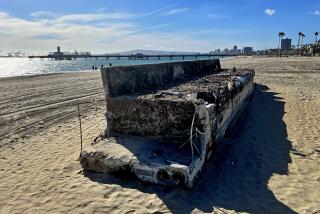Caribbean beaches vanishing
- Share via
SAN JUAN, PUERTO RICO — The Caribbean’s sand is disappearing at alarming rates, as thieves feed a local construction boom.
Caribbean round grains, favored in creating smooth surfaces for plastering and finishing, are being hauled away by the truckload during the night. On some islands not much bigger than Manhattan, towns and ecologically sensitive areas are now exposed to tidal surges and rough seas.
In Puerto Rico, thieves once mined the dunes in the northern coastal town of Isabela, said Ernesto Diaz of the Department of Natural Resources. But now they are stealing the beaches of the tiny island of Vieques, which is 52 square miles.
Among the hardest hit is Grenada, where officials are building a $1.2-million sea wall to protect the 133-square-mile island. Large-scale sand thefts have exposed north coast towns to rough seas, said Joseph Gilbert, minister of works and environment.
One of the region’s largest sand thefts targeted Jamaica, where nearly 100 truckloads were swiped from private property in the northwest, exposing mangroves and a limestone forest to wind and waves.
About 706,000 cubic feet of sand was taken in late July, enough to fill 10 Olympic-sized pools, said Jamaica’s mines commissioner, Clinton Thompson, who suspects that government officials were involved.
“I was surprised at the amount,” he said. “This one could not have been stolen without persons knowing about it.”
Police have refused to comment on their investigation.
Illegal sand mining in the Caribbean began in the 1970s, when people with shovels stole small amounts for construction because most homes were built with wood. But the thefts increased as builders switched to concrete homes and have gotten bigger with the rise in construction of resorts and hotels -- built for tourists drawn by the Caribbean’s immaculate beaches. An estimated 80 new hotels and resorts are expected to open in the Caribbean through 2012, according to Smith Travel Research.
Some islands offer local quarries or designate certain beaches for mining, but large-scale nighttime thefts persist despite police patrols. Thieves now use front loaders and other heavy equipment instead of shovels.
“If we continue to mine the beaches the way we’ve been doing, we will have no sand to boast about. Just sea and sun,” Gilbert said.
No one knows how much sand has been carted away, but the islands of Tortola, Anguilla and St. Vincent are now vulnerable to flooding, said Gillian Cambers, associate researcher at the University of Puerto Rico. Up to two-thirds of sand dunes in Tortola and Nevis have been decimated, she said.
In Barbuda, illegal sand miners dug a 23-foot crater that damaged a freshwater aquifer. Saltwater seeped in, and droppings from cows and donkeys contaminated the exposed aquifer, which is now unusable, said local environmentalist John Mussington.
If caught, thieves face light fines and jail time that critics say are unequal to the crime. Grenada, for example, imposes up to $190 in fines, less than the cost of a single load of sand.
Gilbert said he is “appalled” and called for more oversight to prevent loss of the region’s treasured shores.
“We should take action now,” he said. “Or otherwise we will lose our beaches.”
More to Read
Sign up for Essential California
The most important California stories and recommendations in your inbox every morning.
You may occasionally receive promotional content from the Los Angeles Times.













